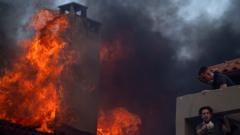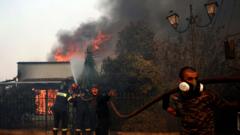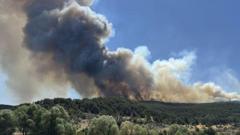According to the American Lung Association’s annual report, approximately 46% of Americans live in areas with unhealthy levels of ozone and particulate matter, jeopardizing their health and well-being.
# Over 156 Million Americans Exposed to Deteriorating Air Quality, Alarm Rises

# Over 156 Million Americans Exposed to Deteriorating Air Quality, Alarm Rises
Recent findings reveal alarming statistics on U.S. air quality, indicating nearly half the population suffers from pollution-related health risks.
In a detailed evaluation by the American Lung Association released in its annual State of the Air report, it was uncovered that around 156 million Americans, which constitutes approximately 46% of the country’s population, are living with unsafe air quality conditions characterized by unhealthy levels of ozone, particulate pollution, or a combination of both. The report warns that proposed reductions to environmental protection policies by the Trump administration could exacerbate this dire situation.
“Protecting air quality has been essential for safeguarding lung health and overall public health,” stated Panagis Galiatsatos, a pulmonologist at Johns Hopkins School of Medicine and spokesperson for the American Lung Association. He underscored the critical role of legislation, particularly the Clean Air Act, in ensuring healthier air quality for citizens.
The report meticulously assessed pollution levels between 2021 and 2023, a timeframe that coincided with one of the most severe wildfire seasons in Canadian history. It documented air quality metrics across counties and cities, assigning grades from A to F based on pollutant levels. Although air quality in the U.S. has shown improvement since the Clean Air Act was legislated in 1970—leading to nearly an 80% decrease in key pollutants—millions of Americans still suffer from pollution-related ailments that can lead to serious health issues, including an elevated risk of premature death.
Specifically, the analysis found that at least 156.1 million individuals are in regions with the lowest air quality rating of F for at least one type of pollutant. Furthermore, about 42 million individuals reside in counties that failed to meet standards across all three pollutant measures. Out of 885 counties monitored for air quality, a staggering 480 counties registered failures based on at least one pollutant benchmark.
As this alarming report comes to light, public health advocates are emphasizing the necessity for stringent measures to preserve and enhance the air quality throughout the United States.
“Protecting air quality has been essential for safeguarding lung health and overall public health,” stated Panagis Galiatsatos, a pulmonologist at Johns Hopkins School of Medicine and spokesperson for the American Lung Association. He underscored the critical role of legislation, particularly the Clean Air Act, in ensuring healthier air quality for citizens.
The report meticulously assessed pollution levels between 2021 and 2023, a timeframe that coincided with one of the most severe wildfire seasons in Canadian history. It documented air quality metrics across counties and cities, assigning grades from A to F based on pollutant levels. Although air quality in the U.S. has shown improvement since the Clean Air Act was legislated in 1970—leading to nearly an 80% decrease in key pollutants—millions of Americans still suffer from pollution-related ailments that can lead to serious health issues, including an elevated risk of premature death.
Specifically, the analysis found that at least 156.1 million individuals are in regions with the lowest air quality rating of F for at least one type of pollutant. Furthermore, about 42 million individuals reside in counties that failed to meet standards across all three pollutant measures. Out of 885 counties monitored for air quality, a staggering 480 counties registered failures based on at least one pollutant benchmark.
As this alarming report comes to light, public health advocates are emphasizing the necessity for stringent measures to preserve and enhance the air quality throughout the United States.





















